10 Things I Learned From My 1st Trail Race
A few weeks ago I ran in my 1st trail race, the McKay Hollow Madness 25K at Monte Sano State Park in Huntsville, AL. While I have run plenty of road races the last couple years, this trail race was a new experience for me, and I have been thinking about the things I learned running on the trails with 300 other people at Monte Sano.
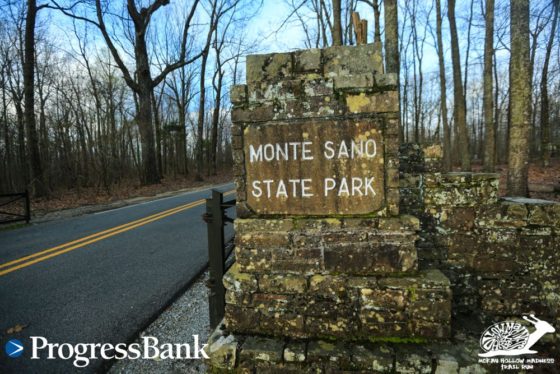
Photo Credit: Progress Bank and werunhuntsville.com
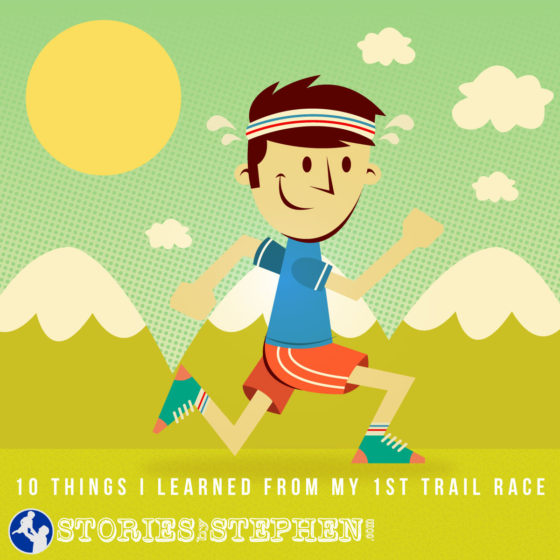
Graphic designed by FreePik.com
1.Your pace depends on the pace of those in front of you on the trail.
It is not easy to pass people in a trail race, and many of the trails in this race were single-tracks. Even in a crowded marathon you can weave around other runners if you are willing to use the extra energy to do so, but on the trails if you get behind a slow or struggling runner, or someone who walks when you want to keep running, there is not much you can do unless they step aside to let you pass or you reach a wider section of the trail.
I learned this the hard way during the first few miles of this 15.5 mile trail race. Since I had never raced on trails and had never set foot in Monte Sano State Park, my plan was to start slow, see what the trail gives me and run as much as I possibly could, only walking if the hills get really intense or I got muscle cramps. This plan seemed fine for that first easy mile of flats and descents, but as soon as we hit some climbs in mile 2, there was a long line of people walking in front of me, which meant I had to walk too. This made the first few miles easy, but slower than I anticipated. I passed people as soon as I got the chance, and many of those people finished 30+ minutes behind me at the end. Next time I will know to start faster and give myself some room on the trail to run my own race instead of the race given to me by others.
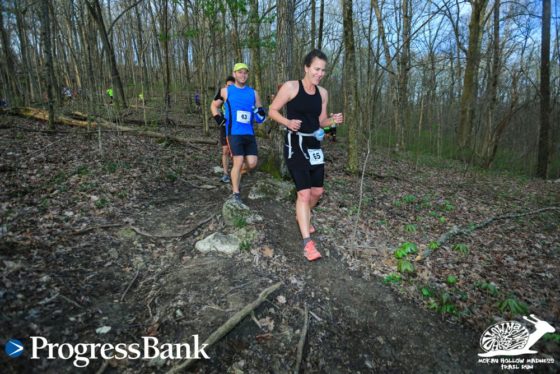
That’s me in the blue shirt and yellow hat. This is actually a good spot to pass people, but most of the trail is less than half this width. Photo Credit: Progress Bank and werunhuntsville.com
2. Pace does not matter in trail races.
I mean, yes it is still a race (at least for a small crowd of fast, experienced trail runners in the front), but there is really no way to maintain a steady pace for any considerable distance like you might try to do while running a half or full marathon. The hills and varying terrain lead to ever-changing paces, and paces much slower than I would run for the same distance in a road race. Really it is difficult to even compare paces on different trails at different parks because there are just too many unpredictable variables. If you are racing to win or beat a personal best for this exact course, then pace is obviously a factor, but many people on the trails are there for lots of reasons besides running fast.
3. The word “run” is used loosely.
Over the 25K course I ran, walked, climbed, crawled, slid, sloshed, scooted, leaped, shuffled and limped (with cramps at the end). I believe the top few runners did run the entire course, or at least 99% of it, but for the most part walking is normal, especially when it comes to hills. Many participants did not even attempt to run up the hills, seeming content to walk the ups and run the downs all day long. I would probably use that same strategy in an ultra-marathon, and I believe many of the other runners on the trail with me that day were ultra-runners who were used to this run/walk method. I was used to never walking in a race until I get muscle spasms around miles 17-20 in marathons. The other methods of movement I listed were simply the result of the ever-changing terrain.
4. The word “trail” is also used loosely.
To prepare for my 1st trail race, I went to Lake Guntersville State Park about 5 times to run on the trails there. (Click here to read about my experience training on those trails.) I thought I was prepared for the different types of terrain I would encounter on race day, but the 2 state parks, while only 45 miles apart, are quite different. Plus I always ran alone on the trails in training, but on race day there were hundreds of other feet muddying up the wet sections of the trail. Besides long sections that were complete mud pits, the race also went across waterfalls, through ditches, up boulders, through caves and sections of pure rock. This was not just a dirt path through the woods with only tree roots as obstacles. The end of the race climbed 600 feet in 4/10 of a mile, basically going straight up a cliff.
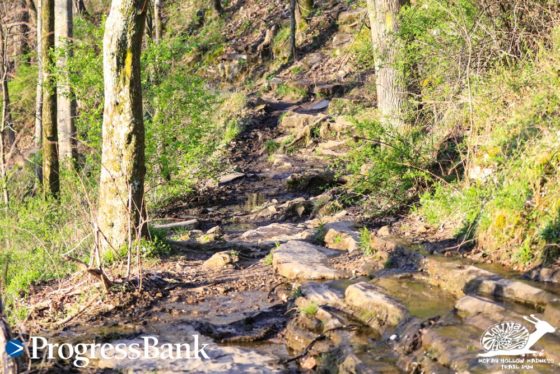
Is that a trail or a stream? Photo Credit: Progress Bank and werunhuntsville.com
5. Every mile is a new adventure in a trail race.
I could say every curve and hill brought something new. Having never run at Monte Sano before, every step was new to me. I never knew if I was about to be running in mud or on rocks. When I was going downhill, I knew I would have to go back up eventually, but I never knew when or how high the next hill would be.

This is one of the many rocky creeks I crossed in my 1st trail race. Photo Credit: Progress Bank and werunhuntsville.com
6. Distances are relative in a trail race.
15.5 miles on technical trails with tons of inclines can be much more difficult than a typical 20 mile long run on the road. Like paces, distances between roads and trails cannot be easily compared. A better way to mentally prepare for a trail race like this might be to look at the previous race results and guesstimate a good time range. If you can run for 3 hours, which might be somewhere around 18-20 miles on the road, then at least you know that you should be able to finish this 25K trail race, with the bulk of the runners finishing between 2:30-3:30. For my training I just used a mix of 10-15 mile road runs with shorter 5-9 mile trail runs, and while I was not fast at this race by any means, I was definitely prepared to finish and at least be a middle-of-the-packer. I actually felt really strong until the crazy climb at the end of the race.
7. People are more social in trail races.
It seemed like everyone else at the race already knew each other, and while it is common for fellow runners to talk a good bit before or after a local road race, I was surprised how much people were talking to each other DURING the race. Part of this is because slower paces on trails make it easier to talk and breathe at the same time, but also it feels like trail runners form a close community. Personally, I usually run with bluetooth headphones, even in races, but I never wear headphones when I’m trail running. No one else does either really, so talking to each other is easier without music to tune out everything else.
8. Aid stations at trail races are like watering holes (with food).
Marathon aid stations mostly just have water and Gatorade, while some occasionally have bananas, orange slices or energy gels
. The 2 aid stations at this trail race had water, Gatorade
, Slim Jims
, cheese crackers
, chocolate chip cookies
, Oreos
, peanut butter filled pretzels
, etc., and I hear that longer trail races serve pancakes, soups, meats and all kinds of other foods at aid stations. Also, going back to my previous point about trail runners being more social, aid stations are social gathering spots. People actually stop and have conversations at the aid stations. They don’t just zoom by grabbing a water cup to drink while they run, but they actually stand around talking to the aid station volunteers and other runners, obviously unconcerned about adding a minute or two to their race times.
9. You use your muscles differently running on trails.
I found my calf muscles getting tired about 3-4 miles into the race after running on lots of rocks for awhile. Then the terrain changed, putting a heavier load on other muscle groups. The steep uphills and downhills started taxing my hamstrings and quads, but after a few miles of this my calves were feeling a bit more refreshed. Then the terrain changed again as we ran in ditches and on dirt logging roads around miles 9-12. This section had long, gradual inclines and declines, instead of steep ups and downs, so it used my leg muscles in a more balanced way. All in all, my legs were feeling great after 10 miles, so I picked up the pace and ran pretty strong for 5 miles. I did get calf and hamstring cramps going up the huge climb during the last half mile, but those quickly went away once I reached the top. Trail running also seems to exhaust my core and upper body more than road running.
10. The scenery is better in trail races.
This should be obvious, but trail races are run through beautiful scenery. Road races sometimes have interesting scenery too, particularly if you are running a marathon through a new city and taking in all the sites there. Here in Guntersville, most of the road races run along Lake Guntersville, so that provides a nice backdrop. However, running through a nice state park means that there are no boring sections, and the always changing terrain means always changing views as well.
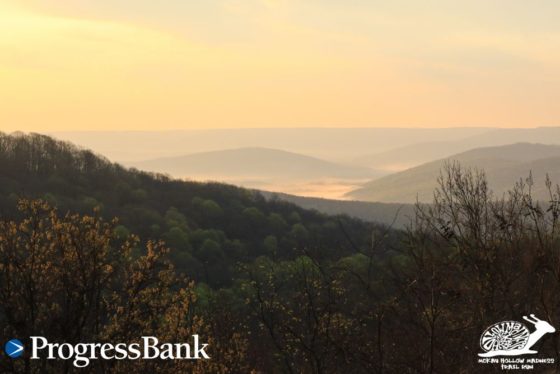
Would you rather see this or a sea of concrete before your race? Photo Credit: Progress Bank and werunhuntsville.com
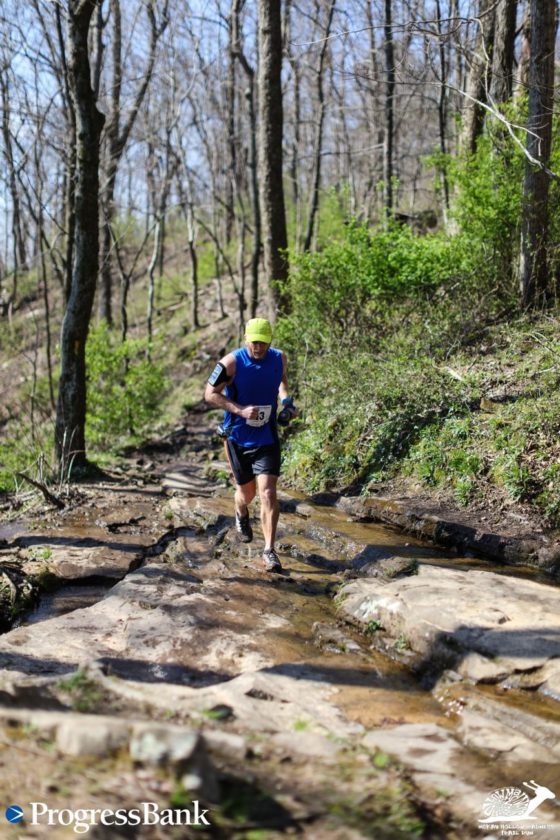
Here I am at 15.5 miles running across the top of a waterfall as I finish the McKay Hollow Madness 25K Trail Race. Photo Credit: Progress Bank and werunhuntsville.com
BONUS
1 last thing I learned is that I love running on trails. They are addictive, and I hope to run many more trail races in the future! Perhaps a 50K is next? Then a 50 miler? Who knows…
Click here to read my other posts about running.

